
You are using an out of date browser. It may not display this or other websites correctly.
You should upgrade or use an alternative browser.
You should upgrade or use an alternative browser.
Preamp Fosi Audio P3 Tube Preamp Headphone Amp Reviews
- Thread starter Fosi Audio Team
- Start date
Genclaymore
New member
The Fosi Audio P3 is a Tube based pre-amp/amplifier with the option to customize your sound using the treble and bass controls. In side of the box, The P3 it self, Bluetooth antenna, pair of GE JAN 5654W tubes, the manual and the power brick.

On the front of the device, you will see a Treble, Volume, Bass knob and the Source switch along with the 3.5mm Headphone port. On the rear, There's a Line in, RCA out, Aux out, power plug, Bluetooth connector and finally a pin hole to reset the Bluetooth connection.
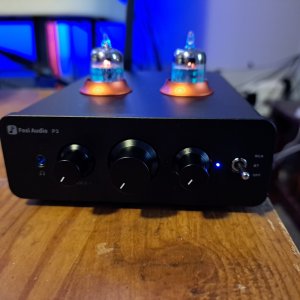

The over all size of the P3 is quite small, as it takes up less room, which is useful when you don’t have a lot of room to use. Its small enough to be placed into an entertainment center or even an end table.
Plugging in the tubes are straight forward, make sure the pins lines up with the connection holes on the tube plug and plug it in. I had a bit of a problem getting the tubes in, since the cut out opening was small, so I couldn’t see if the pins where lined up or not, evidently I got it connected.
P3 can function as a headphone amp, when paired with an external Dac connected to its RCA in, The other option is Bluetooth. The P3 can function as a Bluetooth receiver due to the QCC3031 chip that it uses. The codec’s that it supports are SBC, AAC, APTX/HD and LL. When you set the input to Bluetooth, it starts searching for a device.
When I connected to my phone, I didn’t have an issue. I when I watched a couple of videos and some Netflix shows, There might been a bit of audio delay. But over all I didn’t notice it as to me the audio lined up with the characters talking. I also tried the same with my PC in BT, I was shocked usually that issue happens for me, I watched many videos, and I didn’t have audio lag with my PC as a BT source.
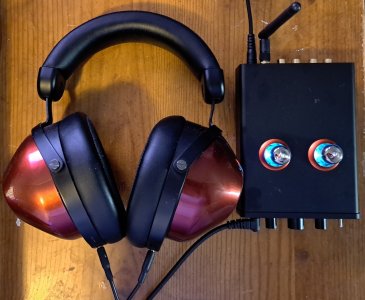
One of the main points to the P3 is being able to control how much treble you want or bass, by default both they’re set to 0. When you twist either of them, you will get a click feel when you reach the center setting. before going past it, moving it all the way to the right will set them to the max setting.
Headphone amp spec of the P3 is 250mw @ 16 Ohm, 150mw @ 32 Ohm, 32 MW @ 250 Ohm and 20mW for 300Ohm. I did run into an issue with the Volume, at very low setting, only one sides play audio, til you raise the volume higher, then both sides play. The problem is by that point the volume knob is a bit away from being too loud, This effect both my Hifiman HE-R9 and my ER2SE IEM.
Sound
When using my HE-R9 I found that I prefer the bass knob set to middle position. If I kept the bass to the lowest then every thing would be thin. If I raised the bass pass mid, it’s only a tad boomy, but if I raise it too much to around 4 o clock position it starts to Too boomy. For the treble I found that I prefer to keep it at lowest setting. Any higher and the details will start to be too much for me. Even with the treble set the lowest, I still heard the details in songs. It wasn’t bright at all, as long I used the lowest knob setting.
The sound stage sounds like its outside my head, like its spread out. With the instruments having good separation, They don’t overlap each other and can be heard clearly. Singers give me a feel as if there on stage, While there back ground singers are on the sides of them. There isn’t any thing else I can say, its all sound good to me.
Conclusion
I liked the Fosi Audio P3, I didn’t have major issues with it, just the minor volume issue I mentioned, but i could be nit picking. Other then that no other issues.

On the front of the device, you will see a Treble, Volume, Bass knob and the Source switch along with the 3.5mm Headphone port. On the rear, There's a Line in, RCA out, Aux out, power plug, Bluetooth connector and finally a pin hole to reset the Bluetooth connection.


The over all size of the P3 is quite small, as it takes up less room, which is useful when you don’t have a lot of room to use. Its small enough to be placed into an entertainment center or even an end table.
Plugging in the tubes are straight forward, make sure the pins lines up with the connection holes on the tube plug and plug it in. I had a bit of a problem getting the tubes in, since the cut out opening was small, so I couldn’t see if the pins where lined up or not, evidently I got it connected.
P3 can function as a headphone amp, when paired with an external Dac connected to its RCA in, The other option is Bluetooth. The P3 can function as a Bluetooth receiver due to the QCC3031 chip that it uses. The codec’s that it supports are SBC, AAC, APTX/HD and LL. When you set the input to Bluetooth, it starts searching for a device.
When I connected to my phone, I didn’t have an issue. I when I watched a couple of videos and some Netflix shows, There might been a bit of audio delay. But over all I didn’t notice it as to me the audio lined up with the characters talking. I also tried the same with my PC in BT, I was shocked usually that issue happens for me, I watched many videos, and I didn’t have audio lag with my PC as a BT source.

One of the main points to the P3 is being able to control how much treble you want or bass, by default both they’re set to 0. When you twist either of them, you will get a click feel when you reach the center setting. before going past it, moving it all the way to the right will set them to the max setting.
Headphone amp spec of the P3 is 250mw @ 16 Ohm, 150mw @ 32 Ohm, 32 MW @ 250 Ohm and 20mW for 300Ohm. I did run into an issue with the Volume, at very low setting, only one sides play audio, til you raise the volume higher, then both sides play. The problem is by that point the volume knob is a bit away from being too loud, This effect both my Hifiman HE-R9 and my ER2SE IEM.
Sound
When using my HE-R9 I found that I prefer the bass knob set to middle position. If I kept the bass to the lowest then every thing would be thin. If I raised the bass pass mid, it’s only a tad boomy, but if I raise it too much to around 4 o clock position it starts to Too boomy. For the treble I found that I prefer to keep it at lowest setting. Any higher and the details will start to be too much for me. Even with the treble set the lowest, I still heard the details in songs. It wasn’t bright at all, as long I used the lowest knob setting.
The sound stage sounds like its outside my head, like its spread out. With the instruments having good separation, They don’t overlap each other and can be heard clearly. Singers give me a feel as if there on stage, While there back ground singers are on the sides of them. There isn’t any thing else I can say, its all sound good to me.
Conclusion
I liked the Fosi Audio P3, I didn’t have major issues with it, just the minor volume issue I mentioned, but i could be nit picking. Other then that no other issues.
Attachments
Here is a review that I did on the Fosi Audio P3 Bluetooth Tube Preamp:
 drive.google.com
drive.google.com
Fosi Audio P3 Review.pdf
 drive.google.com
drive.google.com
watchdogsg
New member
Greetings everyone. Here is a review I did on the P3. This is published on my blog, singaporehifi.blogspot.com
Description

The P3 is a tube-based preamplifier which incorporates a number of features that complements the Fosi Audio V3 integrated amplifier. These is a Bluetooth input, tone controls, a preamp output and a headphone socket.
Physically and visually, the P3 matches the V3 having the same footprint and design. The 7-pin 5654W tubes stick out from the top and hence the P3 needs to be placed on top if you are stacking them. According to Fosi, the tube plates are run at 54V DC. The P3 was originally announced as using 6Ж2П/5725 tubes, but you can switch to those as a substitute. Both tubes were not specifically designed for audio and are available quite cheaply, even for premium vintage brands. This would make tube rolling a lot easier on your wallet.
Three knobs are placed on the front panel, with the larger volume knob in the center, and the bass and treble knobs on the right and left respectively. I found this a bit odd, as it’s more common for the bass knob to be on the left side. A 3.5mm headphone socket is placed on the left side of the panel, while a 3-position rocker switch on the right switches the unit off, or toggles between the Bluetooth or RCA input. Plugging your headphones into the 3.5mm socket automatically mutes output to your speakers.
The tone-control knobs have a physical center detent at 12 o’clock so that you know whether you are boosting or reducing the relevant frequencies, which is useful if you want to bypass them altogether.
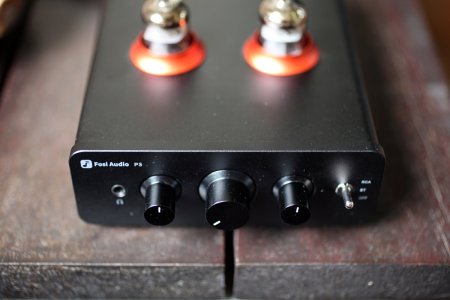
A single pair of RCA input and output sockets are placed on the rear panel, together with the Bluetooth antenna, a small button to reset the Bluetooth pairing, and a DC power inlet for the external 12V power supply. If you want to experiment with power supplies, do take note that the power inlet uses a 5.5/2.5 barrel. I think Fosi should seriously consider adding a second set of line-level inputs - it’s a bit odd for a preamp to only have a single input!
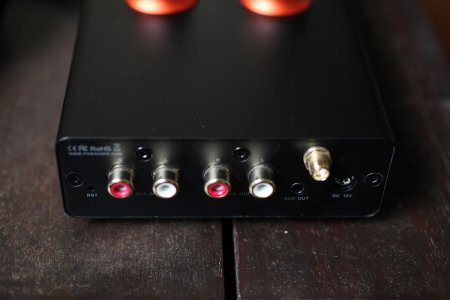
The headphone output is specified to work with loads between 16-300 ohms, with 250mw of power into 16 ohms and 20mw of power into 300 ohms.
The Bluetooth input is based on a Qualcomm QCC3031 chipset that supports Bluetooth 5.1 and SBC/AAC/aptX/aptX HD/aptX LL codecs.
In Use
Out of the box, you will need to install the tubes, hook-up the power supply and other necessary connections before you are good to go. Installation of the tube is tricky as the opening is small, and you can’t see whether the tube pins are aligned with the socket. If your tube pins are bent, straightening them out first makes insertion a lot easier. Fosi has since uploaded a video showing that the decorative ring around the tube socket can be removed to allow easier swapping of tubes. They are really tight, so I recommend you use a non-slip pad to grip the ring before rotating them counter-clockwise. It’s a lot easier to do this with the tube removed.
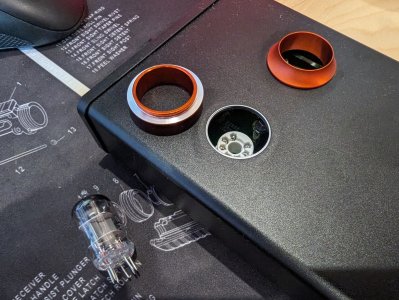
Unlike many tube preamps on the market, the P3 is silent and well-behaved when switched on, and off. There are no dangerous pops or noise. However, I still advise that you follow the regular procedure of switching on the P3 first, before powering on the V3 and following the reverse order when powering down the system.
Switching on the P3 activates cyan LED lights beneath the tubes which is a nice contrast to the orange glow from the tube filaments. The P3 runs very cool for a tube preamp. In fact, the V3 heats up a lot more.
There was noticeable hum from my speakers using the supplied switched-mode power supply, but this was reduced significantly when I substituted the stock power supply with an aftermarket linear power supply. Even with the stock power supply, the hum was only noticeable during silent passages, and with my ears about 30 cm from the speaker. I don’t think it would be an issue for most people unless they have very sensitive speakers. I did not hear any noise through the headphone jack though.
The Bluetooth connected easily to my Google Pixel 7 Pro phone, and the sound quality was quite impressive. Watching Netflix and YouTube videos on my phone showed very little latency and I did not notice any lip sync issues.
Connecting headphones or IEMs to the P3 is going to be a hit-or-miss affair though. With my Letshuoer S12 Pro IEMs (16 ohm impedance), the volume knob was far too sensitive, with noticeable channel mismatch at low to mid-level volumes. Using headphones like my E-Mu Teak (50 ohm) and Beyer DT880 (250 ohm version), sound quality was fine although bass was a bit flabby on the Beyer. The sound was pretty decent on the E-Mu but I would consider the headphone socket as more of a convenience than a substitute for a proper headphone amplifier.
The preamp output on the P3 is variable and changes with both the volume and tone control knobs. This is unlike the preamp output on V3 which is fixed in level (and which should have been labelled as a line-level output instead). This makes it a lot easier to connect the P3 to either a powered subwoofer or active speakers.
If you are familiar with the Fosi Audio range, you could be asking yourself whether the BT20A Pro is the simpler solution, since it has the combined functionality of the P3 and V3. If you hate the idea of tubes, and don’t prioritise sound quality, the BT20A Pro is a feasible option. Sonically though, the V3 or the P3/V3 combo is superior to the BT20A Pro.
Sound Quality
I was worried that the P3 would disappoint. A low-cost tube preamp, operating at a relatively low plate voltage of 54V is hardly a recipe for sonic bliss. Looking at the tube curves for the 5654W tubes, there is a possibility that we may not even be past the “knee” of the curves. As we don’t know the grid voltage used, your guess is as good as mine.
I set up the V3 with my Elac Reference DBR62 speakers and a Geschelli Labs J2 DAC. I then played the same tracks with the P3 connected to the V3. The V3’s volume knob was turned to the maximum, and the level was set using the P3’s volume knob.
With the V3, my usual listening level was with the volume knob at about 11 o’clock. The P3 was set at about 9 o’clock. My guess is that the P3 has some modest gain, which is useful if your source is not loud enough.
On Feels So Good by Chuck Mangione, the Flugelhorn had more vibrancy and presence with the P3. Bass lines gained impact and warmth. With just the V3, images were precise, but small and flat. Listening to 搜神記, Joey Yung’s voice was projected forward into the soundstage, lending a more intimate feel. With the V3, her voice was reproduced with a clean but flatter presentation. With the P3, her voice gained texture, and more emotion.
In terms of resolution, there was a subtle reduction of fine detail with the P3. This was to be expected, as a perfectly transparent preamp does not exist - with high-end preamps being expected to do less harm to the sound. The impact here was well worth the gains in other areas.
With the added midbass and midrange emphasis of the P3, the V3’s tonal balance moved to the warm side of neutral, with a perception of reduced treble energy. If you liked the brighter sound of the V3, you could of course use the tone controls to adjust this to your liking.
Post review, I also tried swapping the supplied 5654W tube for a Russian 6Ж2П. The Russian tube had a more linear and faster sound, at the expense of some midrange warmth and tube “glow”. Feel free to experiment to dial in the sound to your taste.
Conclusion
The P3 does what it should. It adds a pleasing tone to the V3 and addresses the issue of low gain too. Functionally, it fills in the gaps with a Bluetooth input, tone controls, a sub-woofer output and a headphone socket.
It made music more dynamic and life-like, with better tonal saturation and contrast. For a very cheerful price, the P3 is easily recommended - Best Buy.
Description

The P3 is a tube-based preamplifier which incorporates a number of features that complements the Fosi Audio V3 integrated amplifier. These is a Bluetooth input, tone controls, a preamp output and a headphone socket.
Physically and visually, the P3 matches the V3 having the same footprint and design. The 7-pin 5654W tubes stick out from the top and hence the P3 needs to be placed on top if you are stacking them. According to Fosi, the tube plates are run at 54V DC. The P3 was originally announced as using 6Ж2П/5725 tubes, but you can switch to those as a substitute. Both tubes were not specifically designed for audio and are available quite cheaply, even for premium vintage brands. This would make tube rolling a lot easier on your wallet.
Three knobs are placed on the front panel, with the larger volume knob in the center, and the bass and treble knobs on the right and left respectively. I found this a bit odd, as it’s more common for the bass knob to be on the left side. A 3.5mm headphone socket is placed on the left side of the panel, while a 3-position rocker switch on the right switches the unit off, or toggles between the Bluetooth or RCA input. Plugging your headphones into the 3.5mm socket automatically mutes output to your speakers.
The tone-control knobs have a physical center detent at 12 o’clock so that you know whether you are boosting or reducing the relevant frequencies, which is useful if you want to bypass them altogether.

A single pair of RCA input and output sockets are placed on the rear panel, together with the Bluetooth antenna, a small button to reset the Bluetooth pairing, and a DC power inlet for the external 12V power supply. If you want to experiment with power supplies, do take note that the power inlet uses a 5.5/2.5 barrel. I think Fosi should seriously consider adding a second set of line-level inputs - it’s a bit odd for a preamp to only have a single input!

The headphone output is specified to work with loads between 16-300 ohms, with 250mw of power into 16 ohms and 20mw of power into 300 ohms.
The Bluetooth input is based on a Qualcomm QCC3031 chipset that supports Bluetooth 5.1 and SBC/AAC/aptX/aptX HD/aptX LL codecs.
In Use
Out of the box, you will need to install the tubes, hook-up the power supply and other necessary connections before you are good to go. Installation of the tube is tricky as the opening is small, and you can’t see whether the tube pins are aligned with the socket. If your tube pins are bent, straightening them out first makes insertion a lot easier. Fosi has since uploaded a video showing that the decorative ring around the tube socket can be removed to allow easier swapping of tubes. They are really tight, so I recommend you use a non-slip pad to grip the ring before rotating them counter-clockwise. It’s a lot easier to do this with the tube removed.

Unlike many tube preamps on the market, the P3 is silent and well-behaved when switched on, and off. There are no dangerous pops or noise. However, I still advise that you follow the regular procedure of switching on the P3 first, before powering on the V3 and following the reverse order when powering down the system.
Switching on the P3 activates cyan LED lights beneath the tubes which is a nice contrast to the orange glow from the tube filaments. The P3 runs very cool for a tube preamp. In fact, the V3 heats up a lot more.
There was noticeable hum from my speakers using the supplied switched-mode power supply, but this was reduced significantly when I substituted the stock power supply with an aftermarket linear power supply. Even with the stock power supply, the hum was only noticeable during silent passages, and with my ears about 30 cm from the speaker. I don’t think it would be an issue for most people unless they have very sensitive speakers. I did not hear any noise through the headphone jack though.
The Bluetooth connected easily to my Google Pixel 7 Pro phone, and the sound quality was quite impressive. Watching Netflix and YouTube videos on my phone showed very little latency and I did not notice any lip sync issues.
Connecting headphones or IEMs to the P3 is going to be a hit-or-miss affair though. With my Letshuoer S12 Pro IEMs (16 ohm impedance), the volume knob was far too sensitive, with noticeable channel mismatch at low to mid-level volumes. Using headphones like my E-Mu Teak (50 ohm) and Beyer DT880 (250 ohm version), sound quality was fine although bass was a bit flabby on the Beyer. The sound was pretty decent on the E-Mu but I would consider the headphone socket as more of a convenience than a substitute for a proper headphone amplifier.
The preamp output on the P3 is variable and changes with both the volume and tone control knobs. This is unlike the preamp output on V3 which is fixed in level (and which should have been labelled as a line-level output instead). This makes it a lot easier to connect the P3 to either a powered subwoofer or active speakers.
If you are familiar with the Fosi Audio range, you could be asking yourself whether the BT20A Pro is the simpler solution, since it has the combined functionality of the P3 and V3. If you hate the idea of tubes, and don’t prioritise sound quality, the BT20A Pro is a feasible option. Sonically though, the V3 or the P3/V3 combo is superior to the BT20A Pro.
Sound Quality
I was worried that the P3 would disappoint. A low-cost tube preamp, operating at a relatively low plate voltage of 54V is hardly a recipe for sonic bliss. Looking at the tube curves for the 5654W tubes, there is a possibility that we may not even be past the “knee” of the curves. As we don’t know the grid voltage used, your guess is as good as mine.
I set up the V3 with my Elac Reference DBR62 speakers and a Geschelli Labs J2 DAC. I then played the same tracks with the P3 connected to the V3. The V3’s volume knob was turned to the maximum, and the level was set using the P3’s volume knob.
With the V3, my usual listening level was with the volume knob at about 11 o’clock. The P3 was set at about 9 o’clock. My guess is that the P3 has some modest gain, which is useful if your source is not loud enough.
On Feels So Good by Chuck Mangione, the Flugelhorn had more vibrancy and presence with the P3. Bass lines gained impact and warmth. With just the V3, images were precise, but small and flat. Listening to 搜神記, Joey Yung’s voice was projected forward into the soundstage, lending a more intimate feel. With the V3, her voice was reproduced with a clean but flatter presentation. With the P3, her voice gained texture, and more emotion.
In terms of resolution, there was a subtle reduction of fine detail with the P3. This was to be expected, as a perfectly transparent preamp does not exist - with high-end preamps being expected to do less harm to the sound. The impact here was well worth the gains in other areas.
With the added midbass and midrange emphasis of the P3, the V3’s tonal balance moved to the warm side of neutral, with a perception of reduced treble energy. If you liked the brighter sound of the V3, you could of course use the tone controls to adjust this to your liking.
Post review, I also tried swapping the supplied 5654W tube for a Russian 6Ж2П. The Russian tube had a more linear and faster sound, at the expense of some midrange warmth and tube “glow”. Feel free to experiment to dial in the sound to your taste.
Conclusion
The P3 does what it should. It adds a pleasing tone to the V3 and addresses the issue of low gain too. Functionally, it fills in the gaps with a Bluetooth input, tone controls, a sub-woofer output and a headphone socket.
It made music more dynamic and life-like, with better tonal saturation and contrast. For a very cheerful price, the P3 is easily recommended - Best Buy.
Similar threads
- Replies
- 1
- Views
- 222
- Replies
- 1
- Views
- 644
Headphone Amp
Fosi Audio SK01 Headphone Amp Preamp Reviews
- Replies
- 3
- Views
- 478
- Replies
- 5
- Views
- 906
- Replies
- 6
- Views
- 1K

